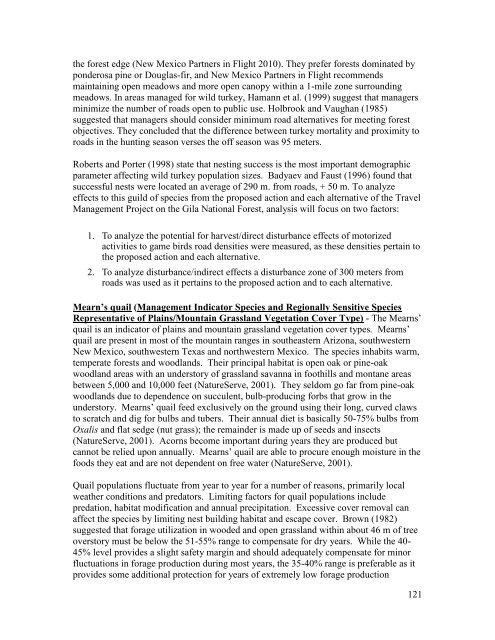Wildlife Specialist report
Wildlife Specialist report
Wildlife Specialist report
Create successful ePaper yourself
Turn your PDF publications into a flip-book with our unique Google optimized e-Paper software.
the forest edge (New Mexico Partners in Flight 2010). They prefer forests dominated by<br />
ponderosa pine or Douglas-fir, and New Mexico Partners in Flight recommends<br />
maintaining open meadows and more open canopy within a 1-mile zone surrounding<br />
meadows. In areas managed for wild turkey, Hamann et al. (1999) suggest that managers<br />
minimize the number of roads open to public use. Holbrook and Vaughan (1985)<br />
suggested that managers should consider minimum road alternatives for meeting forest<br />
objectives. They concluded that the difference between turkey mortality and proximity to<br />
roads in the hunting season verses the off season was 95 meters.<br />
Roberts and Porter (1998) state that nesting success is the most important demographic<br />
parameter affecting wild turkey population sizes. Badyaev and Faust (1996) found that<br />
successful nests were located an average of 290 m. from roads, + 50 m. To analyze<br />
effects to this guild of species from the proposed action and each alternative of the Travel<br />
Management Project on the Gila National Forest, analysis will focus on two factors:<br />
1. To analyze the potential for harvest/direct disturbance effects of motorized<br />
activities to game birds road densities were measured, as these densities pertain to<br />
the proposed action and each alternative.<br />
2. To analyze disturbance/indirect effects a disturbance zone of 300 meters from<br />
roads was used as it pertains to the proposed action and to each alternative.<br />
Mearn’s quail (Management Indicator Species and Regionally Sensitive Species<br />
Representative of Plains/Mountain Grassland Vegetation Cover Type) - The Mearns’<br />
quail is an indicator of plains and mountain grassland vegetation cover types. Mearns’<br />
quail are present in most of the mountain ranges in southeastern Arizona, southwestern<br />
New Mexico, southwestern Texas and northwestern Mexico. The species inhabits warm,<br />
temperate forests and woodlands. Their principal habitat is open oak or pine-oak<br />
woodland areas with an understory of grassland savanna in foothills and montane areas<br />
between 5,000 and 10,000 feet (NatureServe, 2001). They seldom go far from pine-oak<br />
woodlands due to dependence on succulent, bulb-producing forbs that grow in the<br />
understory. Mearns’ quail feed exclusively on the ground using their long, curved claws<br />
to scratch and dig for bulbs and tubers. Their annual diet is basically 50-75% bulbs from<br />
Oxalis and flat sedge (nut grass); the remainder is made up of seeds and insects<br />
(NatureServe, 2001). Acorns become important during years they are produced but<br />
cannot be relied upon annually. Mearns’ quail are able to procure enough moisture in the<br />
foods they eat and are not dependent on free water (NatureServe, 2001).<br />
Quail populations fluctuate from year to year for a number of reasons, primarily local<br />
weather conditions and predators. Limiting factors for quail populations include<br />
predation, habitat modification and annual precipitation. Excessive cover removal can<br />
affect the species by limiting nest building habitat and escape cover. Brown (1982)<br />
suggested that forage utilization in wooded and open grassland within about 46 m of tree<br />
overstory must be below the 51-55% range to compensate for dry years. While the 40-<br />
45% level provides a slight safety margin and should adequately compensate for minor<br />
fluctuations in forage production during most years, the 35-40% range is preferable as it<br />
provides some additional protection for years of extremely low forage production<br />
121
















